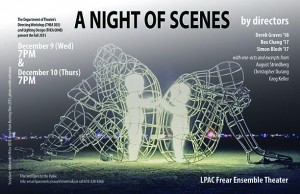Inspire! With Professor Atshan: Teaching Peace
Posted by Anna Weber ’19 January 21, 2016 on her Voices of Youth blog (Reprinted with permission)

Professor Sa’ed Atshan
I walked into my Introduction to Peace and Conflict Studies class unsure. I was unsure if I had any of the answers to the conflicts we would study, unsure of the conflicts in my own life, unsure if this class would help me or leave me to continue to spin towards answers I couldn’t name. But the most eminent question once I walked into the class was where I was going to sit—front and invoke the possibility of having to speak or back and hide from the questions.
I changed my seat three times that day. The truth, however, was that it didn’t matter where I sat. Professor Atshan would have reached me all the way in the back corner because his passion is limitless. He quickly walked in the room, a smile spreading across his face, books and laptop in hand, spouting a metaphor about how this class was an airport and once it starts it is as if the plane has taken off. Trust me, you want to be on that plane.
Professor Atshan lives a life of incessant learning. He started college in the same place as me, Swarthmore College. He then graduated from Harvard University for his Ph.D. in Anthropology and Middle Eastern Studies. Next, he taught at Brown University as a post-doctoral fellow. Now, he is back at Swarthmore teaching students like me. Within his studies, Atshan has won multiple awards and fellowships including the National Science Foundation, the Woodrow Wilson National Fellowship Foundation, Social Science Research Council, the Paul and Daisy Soros Foundation, and a Kathryn Davis Fellowship for Peace. But really beyond his awards, it is kind of inexplicable to detail the impact Professor Atshan has on students. I can’t name it, but he stirs up some notion that tells us to partake in activism for human rights of all kinds; even if we are not personally affected, we have the power to lift the voices of those who are.
So, without further ado, I present you Professor Atshan and perhaps I’m also presenting a passion that he will bring out in yourself.
What do you do, and perhaps more importantly, why do you do it?
I am a professor of Peace and Conflict Studies. I love working with young people and supporting them in thinking about how to make the world less violent and more just.
In the first day of your Introduction to Peace and Conflict Studies class, you asked students to tell the class what they are tokens for, what they are often asked to explain or represent. What are you a token for?
I often have to explain what it means to be gay, to be Palestinian, to be Quaker, and am often met with a generosity of spirit, but every now and then I have to deal with all sorts of prejudices. But I do my best to remain patient and compassionate.
Can you explain where you come from and where you are going? This can be literal or metaphorical if you’d like.
I have always been a bookworm. But I try to escape the protective shell of libraries and to be engaged in activism in the real world. I hope to help build bridges between theory and practice.
As a Peace and Conflict studies Professor, can you tell us what the word “peace” means to you?
Peace is not only about the absence of physical violence—it is also about addressing structural violence. Positive peace, in its truest sense, takes intersectionality into account—understanding how all forms of oppression are interlinked.
What is one thing you hope your students will take away from your class, whatever the class may be?
I hope that they find their unique voice. That they recognize their value and their ability to make a difference in whatever domains they are passionate about. That they are the future—and that they give us hope.
As a student at Swarthmore, you scheduled every minute of your day to maximize studying. You then went to Harvard University and then taught at Brown University. How did you find the motivation to accomplish all of this, study so much, achieve success at some of the best institutions for learning in the United States?
I feel so privileged to have had access to these institutions and resources. With this comes a responsibility to help give voice to those who are voiceless. I try to ensure that my pursuit of knowledge is as ethical as possible and that it helps enact change in the world.
What advice do you have for your students beyond college?
I think it’s tremendously important to be true to yourself. Follow your heart, follow your gut, don’t be afraid to be fabulous, treat others with compassion, and recognize your own gifts and power.













